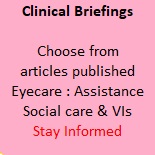Charities & Support Groups
Demand for local sight charities’ services increasing
Demand for local sight charities’ services increasing

LOCAL sight charities are reporting a significant increase in requests for their services as more people are registering as blind or partially sighted than before the pandemic.
Total new registrations received by 13 charities managing the Sight Impairment Register for 19 Council areas in England and Scotland increased by 59% in the year ending March 2022 compared to the previous year and by 18% compared to the year ending March 2020, pre pandemic.
The details are set out in the State of the UK’s Eye Health 2022 report, which has been led by Specsavers and shines a light on the need to draw on the expertise of the whole eye care sector to care for the nation’s eye health and reduce avoidable sight loss.
‘We became increasingly aware of the significant increase in mental health issues among people with a range of eye conditions,’ says Alan Chappell, Charity Manager of East Cheshire Eye Society.
Mark Upton, Chief Executive Officer of MyVision Oxfordshire, says it is increasing its presence in the wider community to provide services closer to home. This is because people it supports are more reluctant to travel since the pandemic and a decrease in good public transport.
Laura Hughes, Chief Executive Officer of Moorvision, says: ‘We received an increase in requests for support in all areas, particularly with access to education and healthcare.’
Fiona Sandford, Chief Executive Officer of Visionary, the umbrella body for local sight charities, says her organisation supports more than 100 local member organisations throughout the UK – working with more than 250,000 people with a wide variety of sight conditions and vision loss.
‘Our incredible community members spend more than £96 million each year, delivering life-changing services and raising awareness of eye health,’ she adds.
‘Nobody should lose their sight from a treatable condition at any time and definitely not while they are waiting to be seen for a problem which has already been identified. This outcome is catastrophic. We must work together for a brighter future.’























